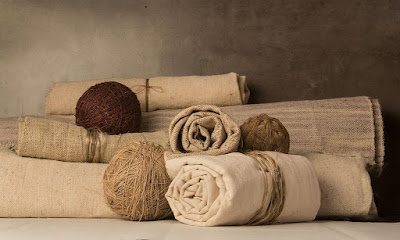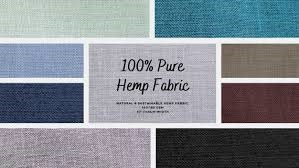No products in the cart.
Hemp, or industrial hemp, is a variety of the Cannabis sativa plant species that is grown specifically for the industrial uses of its derived products. It is one of the fastest-growing plants and was one of the first plants to be spun into usable fibre 50,000 years ago.

First things first,
Let us not confuse Hemp with Marijuana.

It is, filtered into a variety of commercial items, including textiles, paper, biodegradable plastics, clothing, biofuel, insulation, paint, food, and animal feed.
Hemp in the fashion industry
Hemp fabric or hemp textiles are, made from cannabis Sativa fibre or industrial hemp. The usage of hemp fibre or cannabis Sativa fibre as materials for clothing is an old practice. Hemp fibre has been, used for thousands of years and, in 8000 BC, there were materials made from hemp discovered in tombs. Hemp was, used in varieties of applications in early civilizations in Asia, the Middle East and China. For instance, hemp was, used in making paper in China, sailcloth, canvas, ship-rigged, rope, sacks and many more in Asia and the Middle East.
Hemp fabrics are leaving a mark on the fashion industry. Companies in India deals in hemp-based products like hemp seed, seed oils and other variety of products and looking to expand into the fashion arena. The main fabric for all these clothing will be hemp fabric. Soon, people will start noticing the importance of hemp clothing and, we as a society should see a positive change for this fabric.
Difference between hemp & Marijuana:
( https://www.healthline.com/health/hemp-vs-marijuana#hemp )
Most of us find it difficult to differentiate between Hemp and Marijuana, and to clear the same, here we have the difference between the two:
Hemp- The term hemp is, used to mean cannabis that contains 0.3 per cent or less THC content by dry weight.
Marijuana- Cannabis that can get you high is called Marijuana. People all around the world call Marijuana with several names like weed, pot etc.
Marijuana has more than 0.3 per cent THC by dry weight. THC content varies between cannabis plants.
Uses
Cannabis strains high in THC may produce a high and, may be used for medical purposes, like pain management. Strains low in THC but higher in other cannabinoids, like cannabidiol (CBD), may also produce beneficial effects but will not get you high.
Hemp, or cannabis with less than 0.3 per cent THC, can also be grown to create other kinds of products, including:
● Paper
● Clothing
● Textiles
● Animal feed
● Plastic
● Food products: hemp seed, hemp milk, hemp protein powder or hemp oil.
Legality
THC content is one of the differences between the two, but other than that, there is one other difference between hemp and Marijuana: legality.
Marijuana, or cannabis containing more than 0.3 per cent THC, is not federally legal.
State laws vary. In some of the states all around the world, it is allowed to be, used medically and recreationally, only. In other states, it may only be, used medically. And in some states, it is still completely illegal.
Takeaway
Both the plants; Hemp and marijuana are both from the same species.
Legally, hemp is defined, as a cannabis plant that contains 0.3 per cent or less THC, while marijuana is a cannabis plant that has more than 0.3 per cent THC.
Benefits of hemp clothing. ( https://www.blabel.in/blogs/hemp-lovers/8-mind-boggling-benefits-of-hemp-clothing )
1- Hemp clothing uses Less Water Without Polluting the Water:
Crops providing us with other fabrics like cotton requires a lot of water for irrigation, which is depleting our freshwater resources. Collective evolution conducted a study; hemp requires a lot less water to grow as compared to cotton. So, we all know how beneficial hemp clothing is for the environment as it will save water. There is minimal use of agrochemicals which eliminates top-soil erosion caused due to logging. Water bodies such as rivers, lakes, streams, etc. will not be polluted any more.
2- Hemp Requires Less Land To Grow
The land required to cultivate hemp is much lesser, almost half the area required to grow cotton. Also, hemp can produce three times more fibre than cotton in the same land. Briefly, hemp cultivation and production would not put undue stress on our planet.
3- Hemp Is Antimicrobial And Durable
Hemp fabric is active against microbes in nature, which will help the clothes to stay clean for a longer time and also it will also prevent from bacteria which causes bacteria.
Hemp is much stronger and more durable compared to other natural fibres, the reason being; its antimicrobial properties.
The garments which are, made from other materials become distorted after multiple uses. Hemp clothing holds its shape and will last much longer!
4- Hemp Fabric Softens With Time
Hemp fabric is incredibly comfortable and stylish to wear. Hemp clothing gets softer with every wash. Why buy clothes that wear out when you can have fashion that wears in.
5- Hemp Saves You From UV Rays
Hemp fabric has a natural feature to keep you safe from the UV rays.
Overexposure to the harmful sun rays can cause skin cancer and many other irreversible skin problems. Sun protective clothing can save your skin!
Hemp clothing is a must-have in your wardrobe. It makes sure it is hypoallergenic and hence suitable for every skin type. It is highly useful for various outdoor activities, because of its anti UV feature.
6- Hemp Is The Strongest Natural Fibre
Oops! Did you just mistakenly hit your shirt against the door and it got torn off?
You need not worry, hemp fibre is the strongest natural fibre that holds the fabric tight! This makes hemp an abrasion-resistant fabric.
Natural-fiber clothing like hemp is, created from the naturally occurring fibres of plants. Being natural, hemp fibre is also biodegradable. It is tightly woven, yet very breathable and surprisingly soft. It is created without toxins or unnatural processes and does not cling to the body.
Hemp! The next big fabric in the market. (https://www.forbes.com/sites/pamdanziger/2019/10/03/why-the-fashion-industry-needs-to-turn-on-to-hemp/#75578044154a )
We are all aware of how the fashion industry is responsible for depleting the environment and how it is the second most polluting industry worldwide. The consumers, especially the younger generation, are demanding more sustainable and environmentally responsible products, and Hemp fabrication could open the door to more American’s closets.
Hemp is a more sustainable, organic and regenerative agricultural crop and most everything that you can make with cotton can be, made with hemp, with way less impact on the Earth.
By choosing Hemp fabrics, you make the right choice for yourself and the planet!



